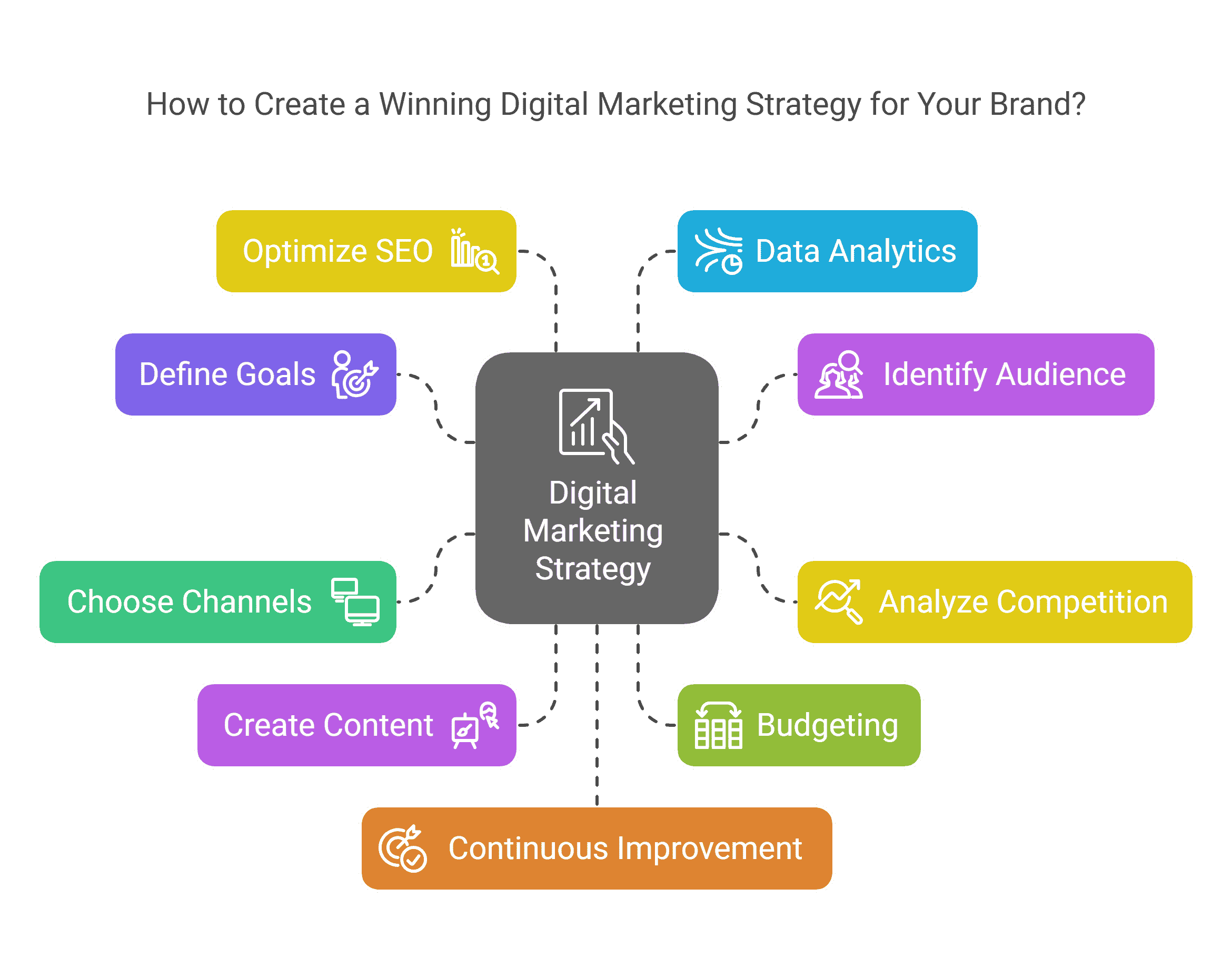Creating a winning digital marketing strategy for your brand involves several key steps, including defining your goals, analyzing data to continuously improve your efforts. A step-by-step guide to help you create a successful digital marketing strategy:
1. Winning Digital Marketing Define Your Goals
Before you start any digital marketing campaign, it’s essential that you define what you want to achieve. Your goal could be: Increasing brand awareness
- Generating traffic for your website
- Generating leads
- Increasing sales
- Growing social media presence
- Building customer loyalty
Make sure that your goals are SMART (Specific, Measurable, Achievable, Relevant, and Time-bound).
2. Identify Your Target Audience
Understanding your audience is crucial to developing a strategy that will appeal to them. To outline your target audience:
- Perform market research: Who are your target customers? What are their demographics (location, gender, age)?
- Create buyer personas: These are detailed personas for your ideal customers based on your research.
- Segment your customer base: Tailor your strategy based on different customer types (e.g., new vs. returning customers).
3. Analyze Your Competition
It helps you identify opportunities and gaps in the marketplace. This can involve:
- Studying their online presence: Review their social media, email marketing, website and advertising strategies.
- Identifying their strengths and weaknesses: What are they doing well? Where can you differentiate?
Winning Digital Marketing: Key Elements for Success
- Use competitive research tools: You can get information on competitor performance using tools such as SEMrush, Ahrefs, and SimilarWeb.
4. Choose the Right Digital Marketing Channels
Depending on your target audience and objectives, select the appropriate channels. Some of the well-known digital marketing channels include:
- Social Media Marketing: Platforms like Instagram, Facebook, LinkedIn, Twitter, Youtube and Pinterest.
- Search Engine Optimization (SEO): Making your website SEO friendlier so that your site will rank higher in search engine listings.
- Pay-Per-Click (PPC) Advertising: Google Ads, social media ads, E-Commerce ads, etc.
- Email Marketing: Building and nurturing an email list.
- Content Marketing: Creating blog posts, videos, podcasts, and other content that provides your audience with value.
- Influencer Marketing: Partnering with influencers for expanding your audience.
Make sure you keep your channel selection consistent with where your audience is investing their time.
5. Create High-Quality Content
Content is the most important part of digital marketing. To create engaging content:
- Understand your audience’s preferred content formats: Are they more interested in blogs, videos, infographics, podcasts?
- Offer value: Your content should educate, entertain, or provide any solution to a problem for your audience.
- Use a content calendar: Schedule and plan content ahead of time so that you can remain consistent.
6. Budgeting and Resource Allocation
A successful strategy requires sufficient resource provision. Consider:
- How much will you be spending on paid advertising?
- Do you have the necessary team in place (e.g., content creators, social media managers, designers)?
- Tools and software: Invest in e-mail marketing software, analytics, or automation software.
Monitor your spending and make adjustments according to performance.
7. Optimize for SEO
SEO is the key to organic growth. Focus on:
- On-page SEO: Ensure that your website is keyword-optimized, title-optimized, meta description-optimized, and heading-optimized.
- Off-page SEO: Creating high-quality backlinks to boost the domain authority.
- Technical SEO: It should be fast, mobile-friendly, and free from all the technical problems that could have a negative effect on ranking.
8. Implement Data Tracking and Analytics
Use tools like Google Analytics, social media insights, CRM data will allow you to analyze performance. This will help you understand:
- Which channels are most effective
- What type of content drives the most engagement
- How your site’s users interact with your site and which parts are most effective
Monitor consistently KPIs such as traffic, conversion rates and return on investment.
9. Test, Learn, and Optimize
Digital marketing requires continuous tweaking. Run A/B tests, analyze your results, and refine your campaigns. Don’t be afraid to test various:
- Ad copy and visuals
- Landing pages
- Email subject lines and content
Use the data that you collect to refine your strategy and improve over time.
10. Stay Updated with Trends
The digital marketing landscape evolves rapidly. Stay current with what’s trending by:
- Following industry blogs, webinars, Online present and podcasts
- Experimenting with new tools and features (e.g., Social-Media, AI-powered marketing tools)
Adapting to algorithm changes on platforms like Google, LinkedIn and Facebook
Conclusion
A winning digital marketing strategy is a blend of clear objectives, understanding your audience, choosing the Most Effective channels, creating content that resonates and continually optimizing based on performance data. By staying consistent and adapting to changes in the targeted market, your brand can build a strong, long-lasting digital presence.
Would you want help with any specific part of this strategy, like Market changes, content ideas or the structure of the PPC campaigns?

